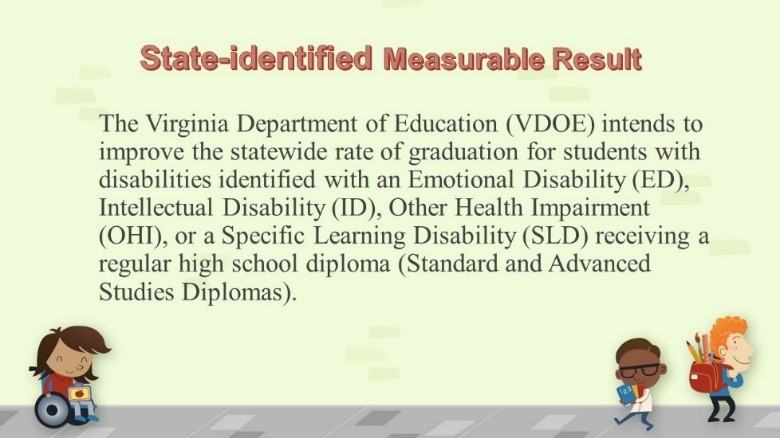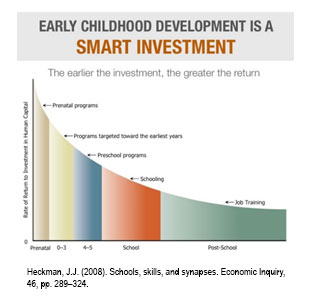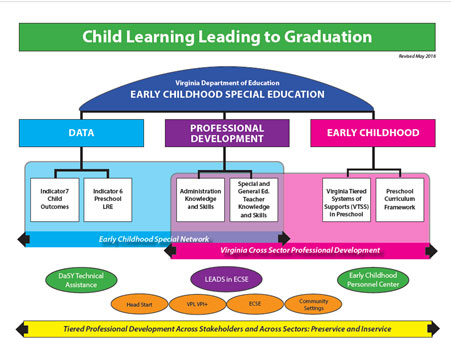Data
State-Level and Division-Level Data
Section 618 of the Individuals with Disabilities Education Act (IDEA) requires that each state submit data about children with disabilities, ages 3 through 21, who receive special education and related services under Part B of IDEA. The U.S. Department of Education Office of Special Education Programs (OSEP) collects data from states and provides reports to Congress. In Virginia, data is reported for children ages birth through five who receive special education and related services under Part B of IDEA.
IDEA requires states to report state-level and division-level indicator data on the performance of students with disabilities. In Early Childhood Special Education (Section 619 of IDEA), there are three data indicators required by OSEP:
More information is available at the Virginia Department of Education (VDOE) website.
Indicator 6:
States are required to report to OSEP:- the percent of children aged 3 through 5 with Individualized Education Programs (IEPs) who attend a regular early childhood education program and receive the majority of special education and related services in the regular early childhood program.
- the percent of children aged 3 through 5 with IEPs who attend a separate special education class, separate school, or residential facility.
Indicator 7:
States are required to report to OSEP:- the percent of preschool children aged 3 through 5 with IEPs who demonstrate improved:
- positive social emotional skills (including social relationships),
- acquisition and use of knowledge and skills (including early language/communication and early literacy), and
- use of appropriate behaviors that meet their needs.
Indicator 12:
States are required to report to OSEP:- the percent of children referred by Part C prior to age 3, who are found eligible for Part B, and who have an IEP developed and implemented by the beginning of the school year if they turn age two by Sept. 30 of that school year or by their third birthday.
State Performance Plan (SPP) and Annual Performance Report (APR)
IDEA requires states to submit a performance plan which includes baseline data, targets, and improvement activities for the data indicators. This information is outlined in the Virginia State Performance Plan (SPP).
States are to provide annual reports on the state-level data and progress toward meeting state targets described in the state’s special education SPP. Progress is described in the Virginia Annual Performance Report (APR).
States are also to provide individual school division-level data and to report on whether the divisions met state targets described in the state’s special education SPP. The Annual Special Education Performance Report to the Public provides division-level data and compares the division’s performance to the state’s targets.
State-identified Measurable Result (SIMR) and State Systemic Improvement Plan (SSIP)
U.S. Department of Education Office of Special Education Programs (OSEP) is implementing a Results-Driven Accountability (RDA) system under IDEA. RDA shifts OSEP’s accountability efforts from a primary emphasis on compliance to a framework that focuses on improved results for children with disabilities while continuing to ensure states meet IDEA requirements.
States are required to have a State-identified Measurable Result (SIMR). This is a goal identified by each state that is designed to improve results of students with disabilities. The State Systemic Improvement Plan (SSIP) outlines how this goal will be addressed. To read more about Virginia’s SIMR and SSIP click here.

Early Childhood Special Education

Virginia Early Childhood Special Education Network
- create a system of partnerships with leaders in early childhood special education in order to build and sustain capacity of quality early childhood programs;
- promote collection and use of valid, reliable, and accurate data for Indicators 6 and 7;
- promote the use of quality curriculum-based assessment practices; and
- explore how preschool Virginia Tiered Systems of Supports (VTSS) will be implemented and connected to K-12 VTSS to provide a full continuum of supports.
- Promote quality inclusive practices aimed at increasing access, participation, and supports for preschool children with disabilities.


